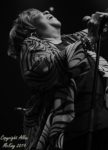 Well, that was all a bit intense; four nights of gigs spread across North and West London (and those are just the ones I opted for – there were plenty of other great gigs across the capital, but you can only be in one place at a time). With so much on offer, the choices weren’t easy, but I witnessed four cracking gigs, all headlined by bona fide legends and with some astonishing up-and-coming support acts. And it’s the only festival I’ve done where I could get a decent shower and sleep in a comfortable bed.
Well, that was all a bit intense; four nights of gigs spread across North and West London (and those are just the ones I opted for – there were plenty of other great gigs across the capital, but you can only be in one place at a time). With so much on offer, the choices weren’t easy, but I witnessed four cracking gigs, all headlined by bona fide legends and with some astonishing up-and-coming support acts. And it’s the only festival I’ve done where I could get a decent shower and sleep in a comfortable bed.
Mavis Staples & Stone Foundation @Roundhouse 04/07/19
This was all about the songs (and Mavis Staples’ incredible voice). No long solos; just deliver the song and the message and move on to the next one. Stone Foundation delivered a powerful support set for Mavis, for the second time in three days and demonstrated why the are the new soul vision. All the elements fit, the songs are strong and the horns and Hammond are the perfect icing on the cake. The finale of “Tear Your Playhouse Down” leaves the crowd elated and ready for the main event.
Mavis Staples is almost the same age as my mum (Happy Birthday for Wednesday, Mavis). The passion for the music is undimmed and the voice is still a force of nature. The audience would happily listen to the classics (who wouldn’t want to hear “Slippery People”, “For What It’s Worth” and “Respect Yourself”), but Mavis also has a new album out at the moment and the title song “We Get By” fits seamlessly in as the set draws to a close. By the end you’re left in no doubt; you have been in the presence of a legend. You have been Mavised.
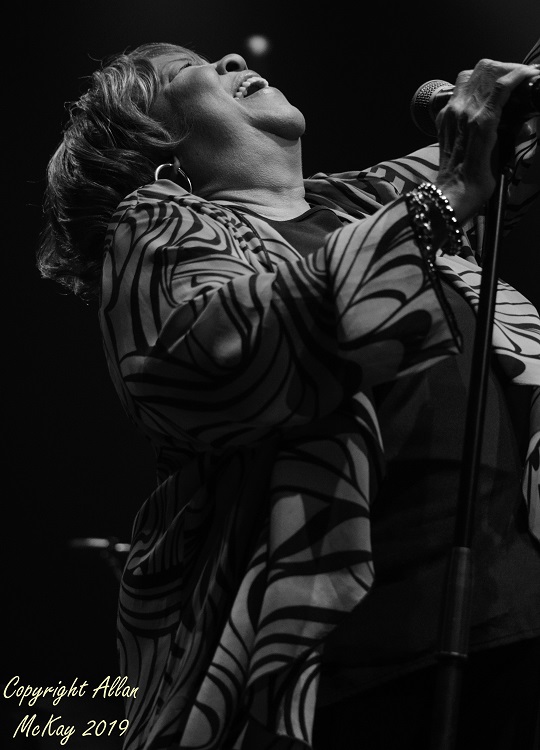
Mavis Staples
Maceo Parker, Down to the Bone and Jen Kearney @Roundhouse 05/07/19
If Thursday was all about the songs and the singers, Friday at Roundhouse was about two things; virtuoso playing and, most importantly, the FUNK. All three sets combined jazz and funk in various proportions with a few other elements thrown in. Jen Kearney opened with a short but powerful set with Latin overtones and hints of Steely Dan at times. Superb instrumental performances from the whole band and powerful vocals from Jen herself. Definitely one to watch. And then Down to the Bone ramped up the atmosphere before the headliner with a set of jazz-funk instrumentals with hints of New York and Cuba and nods towards the Average White Band, Nuyorican Soul and maybe very early Chicago. Great fun and fabulous musicianship.
Then came Maceo. Coming onstage to “1999”, it was obvious that this wasn’t just about musicianship; this was a show. The playing was superb, but Maceo likes to perform as a bandleader, and why not? There was plenty of humour, with a little piano/alto jazz duet on “Satin Doll” to establish whether it was a jazz or funk audience (resoundingly funk, if you needed to know) and a trombone/keys duet on “My One and Only Love”, but it was the funk that was well and truly slam-dunked with a glorious cover of Marvin Gaye’s “Let’s Get it On” featuring a cameo Maceo vocal towards the end. And that was the sound of another legend winning over the Innervisions crowd.
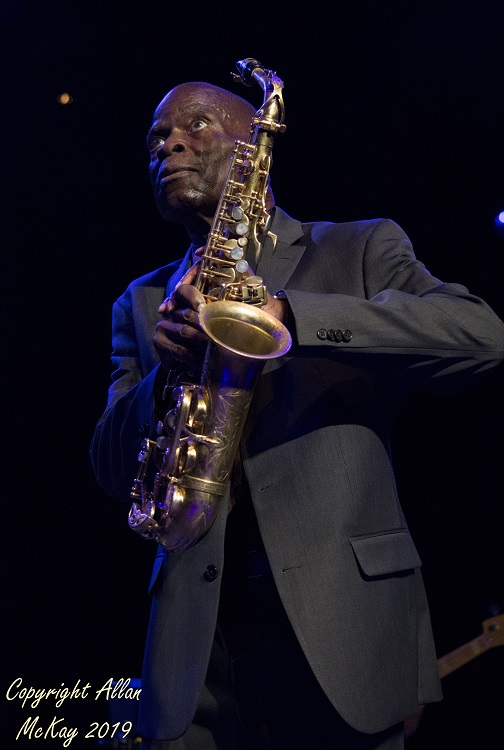
Maceo Parker
Janet Kay & Carroll Thompson with Hannah Francis @Under the Bridge 06/07/19
Hannah Francis has a fabulous voice, no doubt about it, but, as a showcase for new talent, you have to wonder why she only had two songs with backing tracks and no live musicians. Whose decision, I don’t know, but I don’t think it did anyone any favours. And that’s the negativity out of the way. Lovers Rock is by definition a nostalgia thing and the people who get nostalgic about it are really enthusiastic and knowledgeable. And friendly. It was the most relaxed and amiable of all the audiences over the weekend; everyone was there to have a good time.
Janet Kay and Carroll Thompson are known as the two queens of Lovers Rock; they’ve been doing this for years and they’re incredibly good at what they do. They duet and then they alternate short three/four song sets of their classic songs. The difference this time is that they both have covers albums out at the moment so we’re treated to Carroll covering “Make it With You”, “Where Do Broken Hearts Go?” and “Take Another Little Piece of my Heart”, while Janet covers “Betcha By Golly Wow” and “Wishing On a Star”. The audience is young and old, male and female and multi-ethnic and everyone’s just vibing on the tunes. It’s a perfect demonstration in West London of how we can all live together.

Carroll Thompson
Gilberto Gil & Caravela @Shepherd’s Bush Empire 07/07/19
The final night of Innervisions has me visiting what used to be the BBC Television Theatre in The Bush. Apart from a strange domestic at the bar, this is the most laid-back of all the gigs. It must be a Latin American thing. The music has never been my field of expertise, but it’s always had the feelgood factor and interesting rhythms and, like all of the headliners, Gilberto Gil is a legend in the spheres of music and politics.
The night opened with Caravela, fronted by singer Ines Loubet and with a lineup of guitar, keys, bass, drums and percussion. They wowed the Empire crowd (it may have been a bit partisan) with their superb musicianship and Latin polyrhythms topped off by Ines’ powerhouse vocals. Even a non-dancer like me found the rhythms irresistible. And then it was Gilberto Gil time.
The semi-circular backline looked like a set-up for a cast of thousands (or eight or nine multi-instrumentalists and backing vocalists) with Gilberto seated front and centre with an acoustic guitar for the opening three songs, which were all new and ebbed and flowed through stylistic and personnel changes as Gilberto worked solo, played duets and did full band arrangements, before changing up to electric and getting to his feet. However deficient your dancing feet may be, you can’t resist the seductive rhythms that will have you tapping your feet and your fingers and singing along to the wonderful melodies. Another legend whose reputation is well-earned.
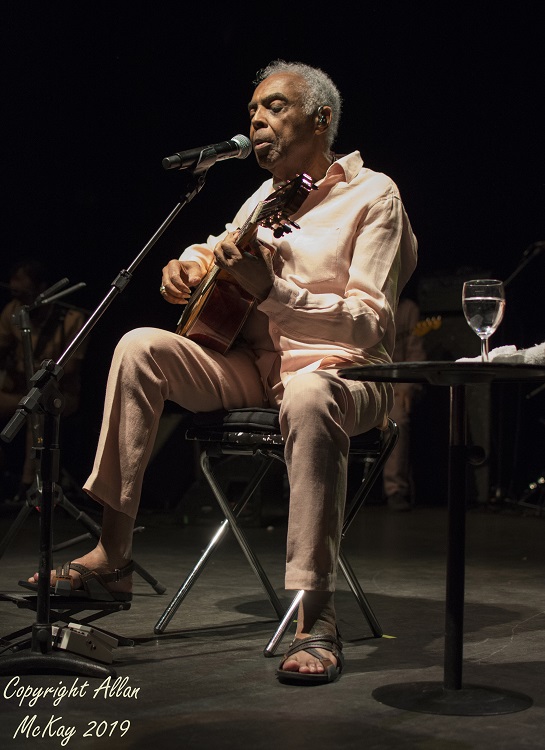
Gilberto Gil
And that was it for Innervisions 2019. Can’t wait for 2020.
Ok, call me obsessive if you like but as well as listening to a lot of albums and going to as many gigs as I can, I also read the odd book or two about music and popular culture and many of those are worth sharing with anyone who checks out MusicRiot regularly. This list was difficult to pin down to five from the start, but it became even more difficult on Christmas Day when I was given a copy of the Donald Fagen memoir/tour diary/article compilation, “Eminent Hipsters”. So I guess that’s a pretty good place to start.
“Eminent Hipsters” – Donald Fagen
 Where do I start with Donald Fagen? With Walter Becker, he was half of one of my favourite 70s bands, Steely Dan and then went on to release the classic solo album, “The Nightfly” in 1982, followed (not too closely) by “The Kamakiriad” in 1993. You’ve probably guessed by now, I’m a bit of a fan. “Eminent Hipsters” is partly an explanation, through a series of articles, of the factors which influenced the Steely Dan sound (cool jazz, cop dramas and wise-ass comedians) and the Donald Fagen solo sound (science fiction and mid-century paranoia). If you love the music, you’ll be fascinated by these observations about its roots. The second part of this slim volume is devoted to Fagen’s diary from the 2012 “Dukes of September Rhythm Revue” tour which is, by turn, snarky, moving, insightful and downright hilarious.
Where do I start with Donald Fagen? With Walter Becker, he was half of one of my favourite 70s bands, Steely Dan and then went on to release the classic solo album, “The Nightfly” in 1982, followed (not too closely) by “The Kamakiriad” in 1993. You’ve probably guessed by now, I’m a bit of a fan. “Eminent Hipsters” is partly an explanation, through a series of articles, of the factors which influenced the Steely Dan sound (cool jazz, cop dramas and wise-ass comedians) and the Donald Fagen solo sound (science fiction and mid-century paranoia). If you love the music, you’ll be fascinated by these observations about its roots. The second part of this slim volume is devoted to Fagen’s diary from the 2012 “Dukes of September Rhythm Revue” tour which is, by turn, snarky, moving, insightful and downright hilarious.
Donald Fagen writes in an instantly-identifiable style betraying a debt to Raymond Chandler and Dashiell Hammett, which sneaks in when describing Audrey Hepburn in “Breakfast at Tiffany’s” as getting :”out of that cab on Fifth Avenue in a black dress and pearls in the early morning, I wanted to sip her through a straw”. It’s beautifully written and you can get through it in a few hours; it takes 170 pages to deliver a message that most rock biographies take at least five times as long to get over.
“Bedsit Disco Queen: How I Grew Up and Tried to be a Pop Star” – Tracey Thorn
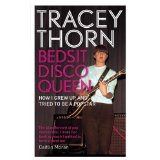 If Donald Fagen’s prose style is easily identifiable, then Tracey Thorn’s is even more so. I’m always impressed when musicians get this right (Peter Hook and Luke Haines also do it particularly well) and, from the first paragraph, this is pitch-perfect ‘Popstar Trace’. The book takes us from the Marine Girls beginnings through the EBTG false starts and eventual success to the beautiful Massive Attack vocals (I’m biased, but you should read about the origins of the modern classic, “Protection” here) and the worldwide Todd Terry-remixed success of “Missing”.
If Donald Fagen’s prose style is easily identifiable, then Tracey Thorn’s is even more so. I’m always impressed when musicians get this right (Peter Hook and Luke Haines also do it particularly well) and, from the first paragraph, this is pitch-perfect ‘Popstar Trace’. The book takes us from the Marine Girls beginnings through the EBTG false starts and eventual success to the beautiful Massive Attack vocals (I’m biased, but you should read about the origins of the modern classic, “Protection” here) and the worldwide Todd Terry-remixed success of “Missing”.
Tracey’s style is perfectly self-deprecatory; you never feel a hint of false modesty and the mentions of famous musicians are always very matter-of-fact, including the story about waiting to pick the kids up from school and being shouted at by George Michael from a Range Rover. This is a wonderful memoir from a genuine pop star.
“Yeah, Yeah, Yeah: The Story of Modern Pop” – Bob Stanley
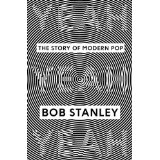 It’s obvious from the outset that this is actually a companion piece to the classic 2012 St Etienne album, “Words and Music”. The album was a voyage through the history of British pop music and the book is an extended verbal remix of the ground covered by the album. What’s equally obvious is that Bob Stanley is both an enthusiast and an insider, which gives him a unique perspective on his subject. He aims to show the links between different styles using not just the music, but also sociological and technological developments. If you’re interested in the history of pop music and you’ve done a bit of research, you might disagree with some of his pronouncements, but it’s a big book and you’ll probably agree with ninety per cent of them.
It’s obvious from the outset that this is actually a companion piece to the classic 2012 St Etienne album, “Words and Music”. The album was a voyage through the history of British pop music and the book is an extended verbal remix of the ground covered by the album. What’s equally obvious is that Bob Stanley is both an enthusiast and an insider, which gives him a unique perspective on his subject. He aims to show the links between different styles using not just the music, but also sociological and technological developments. If you’re interested in the history of pop music and you’ve done a bit of research, you might disagree with some of his pronouncements, but it’s a big book and you’ll probably agree with ninety per cent of them.
The book takes the first NME chart in 1952 as its starting point (which is logical and not controversial) and the end of vinyl as a chart force in 1993 as its end point, when the first Number One singles not to have been released as a 7” single or (a few months later) on vinyl at all topped the charts (if you want to know what they are, you can buy the book ). It’s a slightly more controversial choice but still with a logical basis for someone who grew up in the age of vinyl. The book has an authority derived from Bob Stanley’s experience as a writer and member of a very successful pop group but never slips into the socio-cultural academic approach of, for example, Simon Reynolds. The theme that underpins everything else in this book is that Bob Stanley is still a fan who wants you to come round and listen to his records, and that makes this an unmissable book.
“Here Comes Everybody: The Story of the Pogues” – James Fearnley
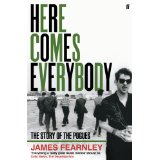 I’ve always been a fan of the “inside story” biography, particularly those that aren’t ghost-written attempts at cultural revisionism. This memoir by James Fearnley is, at times, brutally and crushingly honest about members of The Pogues and he doesn’t spare himself either. The book begins by setting the scene with Shane MacGowan’s departure from the band in 1991 before moving back to Fearnley’s initial meeting with MacGowan at an audition for The Nips in 1980.
I’ve always been a fan of the “inside story” biography, particularly those that aren’t ghost-written attempts at cultural revisionism. This memoir by James Fearnley is, at times, brutally and crushingly honest about members of The Pogues and he doesn’t spare himself either. The book begins by setting the scene with Shane MacGowan’s departure from the band in 1991 before moving back to Fearnley’s initial meeting with MacGowan at an audition for The Nips in 1980.
The book is a (mainly) unsentimental account of the rise and fall of The Pogues from the viewpoint of someone close enough to see everything but with enough distance to retain some objectivity. From the chaotic managerless beginnings through the unpopular but successful stewardship of Frank Murray, the story is underpinned at all times by MacGowan’s unpredictability and seemingly random self-destructive urges. James Fearnley tries very hard to balance the singer’s inexcusable behaviour against the genius of the songs, but it’s up to you if you buy that line; I certainly don’t. My only criticism is that James Fearnley spends a little too much time trying to emphasise the fact that he’s a writer and occasionally introduces unnecessarily florid prose to prove it; putting that aside, it’s still a winner.
“Sounds like London: 100 Years of Black Music in the Capital” – Lloyd Bradley
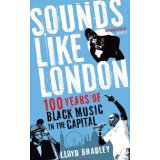 Bear with me for a minute here; this will all make sense presently. Earlier this year I read “How Soon is Now?: The Madmen and the Mavericks who made Independent Music 1975-2005” by Richard King. It’s a very good book and a must for geeks like us, but it attracted a lot of criticism because it didn’t touch on the black music scene. Richard King was even accused, pathetically, of racism in some quarters; you might even have read about it. Personally, I prefer to read authors who write about subjects they understand and that really inspire them; if Richard King didn’t have the expertise, contacts or inspiration to write about the black music scene, then Lloyd Bradley certainly did.
Bear with me for a minute here; this will all make sense presently. Earlier this year I read “How Soon is Now?: The Madmen and the Mavericks who made Independent Music 1975-2005” by Richard King. It’s a very good book and a must for geeks like us, but it attracted a lot of criticism because it didn’t touch on the black music scene. Richard King was even accused, pathetically, of racism in some quarters; you might even have read about it. Personally, I prefer to read authors who write about subjects they understand and that really inspire them; if Richard King didn’t have the expertise, contacts or inspiration to write about the black music scene, then Lloyd Bradley certainly did.
The title is a little misleading; there’s very little about pre-1950s black music, and it also deals with regional English offshoots from the London scene but those aren’t criticisms, just observations. The reason for the comparison with Richard King’s book is that one of Lloyd Bradley’s recurring themes is that black British music has always developed and prospered healthily out of the mainstream when produced and distributed independently.
Once the book reaches the point where Lloyd Bradley can introduce interviews with the players who made black British music happen (the steel pan players, the jazzers, the sound system pioneers, the Britfunk players and the mainstream crossovers Eddy Grant, Janet Kay, Jazzie B and the rest), the narrative really takes off with stories of the sound systems and records being sold out of the back of a car and distributed around the country in the same way. Lloyd Bradley takes us through calypso, ska, reggae, lovers rock, dub, britfunk, 98 bpm, trip hop, jungle, d’n’b, UK garage, dubstep and grime along with a host of short-lived one-way streets with an unassuming and easy authority that is very seductive. If you want an introduction to black British music, this is the book for you.
OK, spoilers alert; I’ve relented. I’ll tell you that the chart-toppers Bob Stanley refers to in 1993 and 1995 respectively are Culture Beat’s “Mr Vain” and Celine Dion’s “Think Twice”, but you should still read the book. Actually you should read all of these books.


